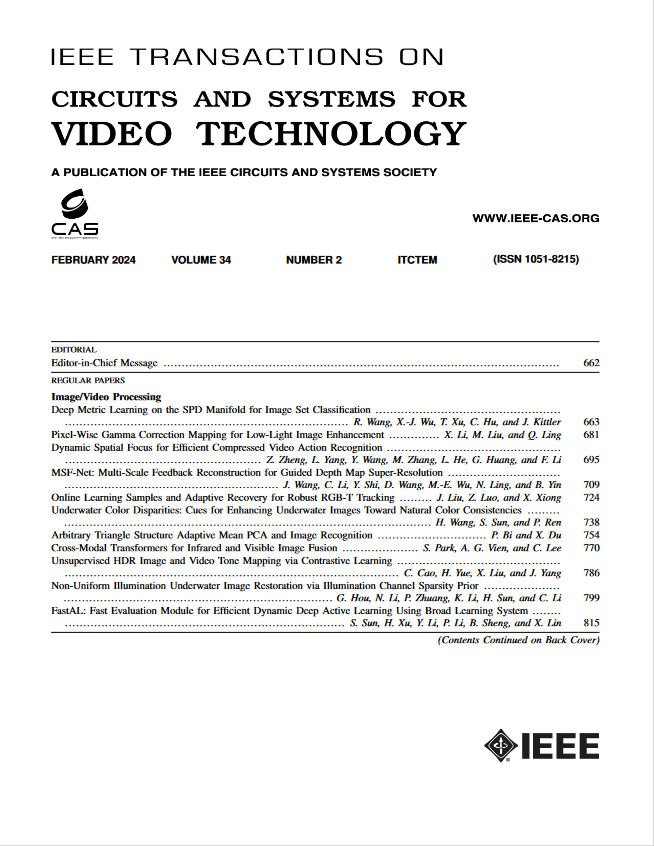红外与可见光图像融合的目标感知泰勒展开逼近网络
IF 8.3
1区 工程技术
Q1 ENGINEERING, ELECTRICAL & ELECTRONIC
IEEE Transactions on Circuits and Systems for Video Technology
Pub Date : 2025-01-01
DOI:10.1109/TCSVT.2024.3524794
引用次数: 0
摘要
在图像融合任务中,关键任务是生成高质量的图像,以突出重点对象,同时增强待理解的场景。为了完成这一任务,并提供强大的可解释性和强大的泛化能力,以产生令人满意的融合结果,使视觉任务(如物体检测及其分割)感到舒适,我们提出了一种新的可解释分解方案,并开发了一个目标感知的泰勒展开近似(T2EA)网络用于红外和可见光图像融合,其中我们的T2EA包括以下关键步骤:首先,通过设计的泰勒展开近似(TEA)网络将可见光和红外图像分解成特征映射;然后,采用双分支特征融合(DBFF)网络对泰勒特征映射进行分层融合。然后,通过逆泰勒展开,对每一层的融合映射进行贡献,以合成令人满意的融合结果。最后,结合分割网络对融合网络参数进行细化,使融合结果更适合目标的分割。为了验证T2EA网络的有效性,我们首先讨论了泰勒扩展层和融合策略的选择。然后,将所选择的SOTA方法在三个数据集(MSRS、TNO和LLVIP)上产生的定量和定性实验结果在测试、泛化以及目标检测和分割方面进行了比较,表明我们的T2EA方法可以在视觉任务中产生更具竞争力的融合结果,并且具有更强大的图像自适应能力。代码可在https://github.com/MysterYxby/T2EA上获得。本文章由计算机程序翻译,如有差异,请以英文原文为准。
T2EA: Target-Aware Taylor Expansion Approximation Network for Infrared and Visible Image Fusion
In the image fusion mission, the crucial task is to generate high-quality images for highlighting the key objects while enhancing the scenes to be understood. To complete this task and provide a powerful interpretability as well as a strong generalization ability in producing enjoyable fusion results which are comfortable for vision tasks (such as objects detection and their segmentation), we present a novel interpretable decomposition scheme and develop a target-aware Taylor expansion approximation (T2EA) network for infrared and visible image fusion, where our T2EA includes the following key procedures: Firstly, visible and infrared images are both decomposed into feature maps through a designed Taylor expansion approximation (TEA) network. Then, the Taylor feature maps are hierarchically fused by a dual-branch feature fusion (DBFF) network. Next, the fused map of each layer is contributed to synthesize an enjoyable fusion result by the inverse Taylor expansion. Finally, a segmentation network is jointed to refine the fusion network parameters which can promote the pleasing fusion results to be more suitable for segmenting the objects. To validate the effectiveness of our reported T2EA network, we first discuss the selection of Taylor expansion layers and fusion strategies. Then, both quantitatively and qualitatively experimental results generated by the selected SOTA approaches on three datasets (MSRS, TNO, and LLVIP) are compared in testing, generalization, and target detection and segmentation, demonstrating that our T2EA can produce more competitive fusion results for vision tasks and is more powerful for image adaption. The code will be available at https://github.com/MysterYxby/T2EA .
求助全文
通过发布文献求助,成功后即可免费获取论文全文。
去求助
来源期刊
CiteScore
13.80
自引率
27.40%
发文量
660
审稿时长
5 months
期刊介绍:
The IEEE Transactions on Circuits and Systems for Video Technology (TCSVT) is dedicated to covering all aspects of video technologies from a circuits and systems perspective. We encourage submissions of general, theoretical, and application-oriented papers related to image and video acquisition, representation, presentation, and display. Additionally, we welcome contributions in areas such as processing, filtering, and transforms; analysis and synthesis; learning and understanding; compression, transmission, communication, and networking; as well as storage, retrieval, indexing, and search. Furthermore, papers focusing on hardware and software design and implementation are highly valued. Join us in advancing the field of video technology through innovative research and insights.

 求助内容:
求助内容: 应助结果提醒方式:
应助结果提醒方式:


